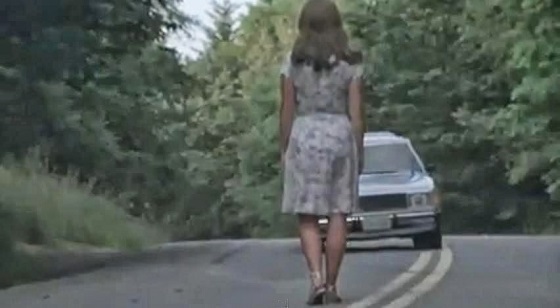In the seventies, a whole subgenre of horror popped up that revolved around the profession of babysitting. Led by movies such as Halloween and When A Stranger Calls, horror films made young girls everywhere think twice about childcare as a moneymaking venture. In 1980, a television movie, simply called The Babysitter, flipped the script on the stalked kinder-care motif by making the sitter the hunter instead of the prey.

The Babysitter stars Stephanie Zimbalist (The Awakening) as Joanna Redwine, a mysterious young woman who comes out of nowhere to make friends with a lonely girl named Tara Benedict (Quinn Cummings from The Goodbye Girl) who spends all of her time peeping on the neighbor boy and talking to her doll. After meeting the girl’s parents, Jeff and Liz (William Shatner from Visiting Hours and Patty Duke Astin from The Swarm, respectively), Joanna is able to turn her awkward friendship with Tara into a live-in babysitting job.

And that’s when Joanna starts to systematically and methodically dismantle the family, first by teaching bad habits to Tara, then by encouraging the recovering alcoholic Liz to drink, and finally, by trying to seduce Jeff. When a neighbor by the name of Dr. Lundquist (John Houseman from The Fog and Ghost Story) gets suspicious and looks into Joanna’s past, he discovers that the woman has some dark baggage. Dr. Lundquist has to convince the Benedicts that their new babysitter is not who she claims to be before she can do any more damage to their family.

Everything about the production of The Babysitter screams made-for-TV movie. It was directed by Peter Medak, who earned his horror credibility by making The Changeling (in the same year as The Babysitter!), but also would go on to have a hand in television series like “The Twilight Zone” and “Faerie Tale Theatre.” The screenplay was written by Jennifer Miller, whose resume is stuffed with TV movies like Deadly Lessons and The Dark Secret of Harvest Home. And, of course, there’s the full cast of television stars – it’s got Captain Kirk, Patty/Cathy Lane, Annie Cooper, Laura Holt, and Grandpa Stratton, all in one place! This all makes The Babysitter a fairly lightweight horror offering, but that doesn’t mean that it’s not a creepy movie.

As mentioned earlier, The Babysitter is an interesting little script-flip on the babysitter subgenre of horror. Although the details of the girl’s story take a while to flesh out, it is clear from the start that Joanna is neither a victim nor a Final Girl. She has qualities that are both ghostly (appearing out of nowhere to cause a car accident) and witch-like (cryptically telling Liz that “if you let me, I can help you” with her marital problems), but at the end of the day, Joanna is just a scheming sociopath who has trouble separating fantasy from reality. But she’s a lot of fun to watch – at one point while talking to Joanna, Dr. Lundquist says “I find your manipulations fascinating.” So do we, Doc. So do we.

While it does have the look of a television movie, cinematographer Rexford L. Metz (The Midnight Hour) brings a few cinematic elements to the film. Metz uses plenty of creepy, almost subliminally rule-breaking camera motion, crossing the line and disorienting the audience through point of view shots and character following one-takes. Most of the movie is very brightly lit, which illustrates the theme that a horror movie doesn’t need a dark shadowy castle to be eerie; anything can happen in the harsh light of day, and in The Babysitter, anything does. It’s photographed like a TV movie, but a very well-shot one.

The score for The Babysitter is an eclectic smorgasbord of stock music, mostly written by Arion Ober (The Incredible Melting Man, Hospital Massacre, Bloody Birthday), Leonard Rogowski (Demonoid: Messenger of Death, Nightbeast), Robert J. Walsh (Leprechaun, Q: The Winged Serpent), and Ole Georg (Creepshow, Galaxina). Because of the use of pre-existing music (and the sheer number of cooks in the kitchen), the soundtrack to The Babysitter is versatile to the point of being schizophrenic, transitioning from a groovy late-seventies pop track one second to a creepy synthesizer melody the next. The music sounds like an early electronic score from the days before electronic music started sounding electronic – it’s not retro-kitsch at all, it’s just a creepy TV score, even if it’s a bit unfocused.

In the last twenty-five years or so, the archetype of the babysitter has gone from victim to villain in plenty of movies like The Hand That Rocks The Cradle, While the Children Sleep, and Emelie. But, whether they admit it or not, all of these twisted tales owe a debt of gratitude to a little early eighties TV movie called The Babysitter.

